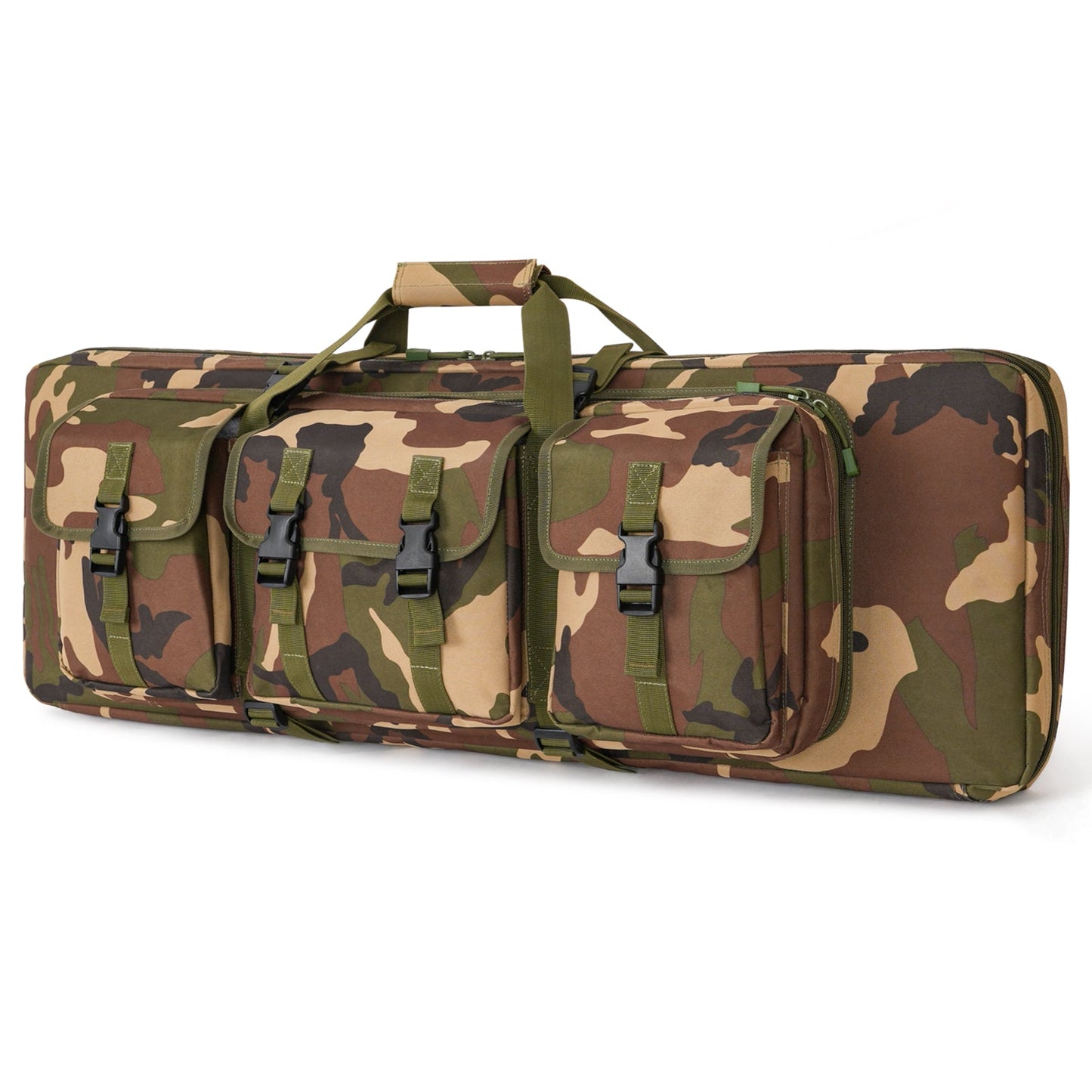
Color used to be completely functional when it came to tactical gear. Camouflage, black, and brown were the go-to colors for concealment and operating well under stress. There has been a dramatic change in tactical backpacks in recent years. There are aesthetic, practical, and psychological reasons for the wide range of colors available currently. Since civilians now employ gear for everyday tasks, the term "tactical" has taken on new meaning in the modern day, and this development affects more than just the military.
These days, your color choices reflect your personality and the message you're attempting to convey. Their contemporary lifestyles are complemented by their traditional practicality. The colors you choose out for your tactical gear convey a lot about your personality and your ability to adapt to various environments.
How Tactical Backpack Colors Have Changed Over Time
The primary use of tactical bagpack colors was in combat. Equipment used by the military had to be able to conceal itself, not attract notice, and continue operating in harsh environments. In World War II, olive drab was designated as the official color, and several types of camouflage were created to suit various types of conflicts.
These simple color patterns were available on tactical backpacks sold to the public in the 1980s and 1990s. Many civilians, law enforcement officers, and adventurers shopped for tactical backpacks in colors reminiscent of the military. The endurance and durability of these items were the most important selling points, while their aesthetic value was secondary.
A fascinating change, nevertheless, has occurred in the allure of tactical gear. In the past, colors were picked out just for their tactical use in warfare. Colors are currently selected according to their aesthetic value, psychological effects, and cultural relevance. These days, there's more to a modern combat bag than meets the eye. It says a lot about the person wearing it and their self-perception.
Why People Choose Traditional Tactical Backpack Colors
The Power of Black ★
Black remains the most popular color for tactical backpacks, and for good reasons beyond tradition. Psychologically, black conveys:
- Authority - Giving the idea of control and ability
- Timelessness - Resisting trends and maintaining relevance
- Versatility - Complementing any environment or additional gear
- Stealth - Minimizing visibility in low-light conditions
In certain cases, black might also be helpful. Tools that operate in harsh environments benefit from this hue since it conceals dirt and wear better than lighter shades. Professionals and everyday people alike appreciate the fact that black tactical geanal appearance even after extensive wear.

In addition to these advantages, there aren't many social cues sent by wearing black in urban areas. At times, tactical gear receives more attention than it needs. Wearing black allows you to conceal your high-tech gear without attracting attention to its tactical nature.
Olive Drab and Camouflage: Connection to Heritage
People who wear classic military colors such as olive drab and other camouflage patterns have a track record of reliability and performance under duress. These hues evoke feelings of endurance, alertness, and expertise, all of which are qualities that many individuals who carry tactical backpacks desire to demonstrate.
Camouflage is very effective for both physical and psychological reasons. Its initial function was to conceal in conflict zones, but nowadays it's commonly employed as a visual shorthand signifying toughness and readiness. These recurrent patterns reinforce the psychological advantage of being prepared for everything, which is a basic principle of tactical organizations.
The Rise of The Urban Gray in Tactical Backpack Colors
The rise in popularity of gray tones may be the most important color trend in tactical bags right now. The rise of the "gray man" mindset in the tactical and planning groups is directly linked to this change.
The idea of a "gray man" stresses the need to stay tactically ready while fitting in perfectly with city life. Instead of traditional tactical colors that could draw notice, gray lets people "hide in plain sight" while still carrying fully usable tactical gear. Situational knowledge and discretion are given more weight in this method, which is something that is increasingly respected in uncertain times.
There are different colors of urban gray, from light silver-gray to darker charcoal. Each has a few slightly different benefits that depend on the situation:
- Light grays blend effectively in corporate and modern architectural settings
- Mid-tones work well across diverse urban landscapes
- Charcoal grays offer near-black functionality with softer visual impact
⚙️ The psychological appeal of gray lies in its neutrality. It projects competence without aggression, preparedness without paranoia, and capability without confrontation. This mix is great for many people who use tactical backpacks today because it makes them feel ready but not aggressive.
Earth Tones and Environmental Considerations for Tactical Backpack Color
Earth tones—ranging from desert tans to forest browns and sage greens—have found renewed popularity among tactical backpack users who spend significant time outdoors. These colors foster a deeper connection with natural environments while maintaining tactical functionality.
A key advantage of earth tones is their adaptability across various terrains. While specialized camouflage excels in specific environments, earth tones perform adequately across diverse settings. This versatility makes them ideal for users who transition between different landscapes.
🌿 Earth-toned tactical backpacks also align with growing environmental consciousness. They visually signal respect for natural settings and often appeal to outdoor Earth-toned tactical backpacks complements rather than intrudes upon wilderness experiences. This connection between color choice and environmental values represents an important evolution in tactical aesthetics.
Bold Colors and Tactical Identity in Tactical Backpack Colors
The most arresting change in tactical bag colors is the arrival of strong blues, reds, oranges, and other vivid colors that immediately subvert conventional ideas of what makes "tactical." These colors have various diverse uses:
- They enable individuals to stand out while keeping utility, therefore allowing personal expression inside the tactical community.
- Bright colors can be used specifically for tactical goals such team identification during coordinated operations or high visibility during search and rescue missions.
- They bridge the gap between tactical functionality and everyday aesthetics, making high-performance equipment more approachable for casual users.
This color range reflects the opening up of military equipment. Color selections have naturally varied to suit various purposes and identities as these goods move beyond enthusiasts, urban commuters, and regular users from military and police enforcement.
Color Coding for Organization and Efficiency in Tactical Backpack
In addition to the color of the tactical backpacks' outside, smart color coding is being used more and more to improve operations efficiency. Many people now personalize their gear with:
- ✓ Colored pouches for different categories of equipment
- ✓ Color-coded zipper pulls for quick identification of compartments
- ✓ Contrasting interior colors to make things easier to see
📊 With this method, color goes from being simply an aesthetic issue to a useful one. In times of high stress, where seconds count, being able to quickly find the right tools by its color can be very helpful. This organization method makes things easier to find and use, even in everyday life.
Seasonal and Environmental Color Considerations for Tactical Backpack
More and more tactical backpack users choose colors depending on the time of year and the surroundings. This flexible method makes things work best in a variety of situations:
- ❄️ Winter environments often call for lighter colors that blend with snow or urban winter landscapes. Some users keep separate bags for winter and summer to stay hidden all year.
- 🏜️ Desert settings favor tans and light browns that minimize heat absorption while blending with the surrounding terrain. These colors are good for hiding and keeping cool at the same time.
- 🏙️ Urban environments typically favor grays, blacks, and subdued blues that blend in with the architecture without standing out. The best urban strategy color often relies on the type of city and how bright it usually is.
This knowledge of the surroundings shows that people who use tactical backpacks are thinking more and more about the situation when choosing gear. Modern tactical gear doesn't have one-size-fits-all answers; instead, it changes to meet the needs of different settings.
Cultural and Regional Color Preferences for Tactical Backpack
There are a lot of different colors of tactical bags. These differences are caused by both real wants and long-held beliefs:
- 🌄 In rural areas, earth tones and traditional camouflage patterns remain popular. This is because they are useful for the environment and have cultural meanings connected to hunting and other outdoor activities.
- 🏢 Urban centers show stronger preferences for grays, blacks, and subdued colors that other muted colors that go with cityscapes while minimizing unwanted attention.
- 🌊 Coastal regions often favor blues and grays that blend with maritime environments and reflect regional aesthetic preferences.
These differences between regions show how tactical gear can be used in different places and with different cultures. As tactical backpacks become more common among a wide range of people, their colors change to reflect the groups they serve.
Look Over the Spectrum of Tactical Backpack Colors
The shift in tactical backpack colors shows a shift away from military gear that is only useful for its purpose and toward things that many people can use. It's good for your mental health and your home to have a wide range of colors today, from classic blacks and camouflage to urban grays, earth tones, and bright colors. The best choice for you will depend on where you are, who you are, and what you want to do. In daily life, these colors mean different things as the line between work and play gets less clear. Smart materials could one day lead to inventions that can change color on the spot. Accept this changing range to make sure your gear can handle any task and combine practicality with personal expression.
